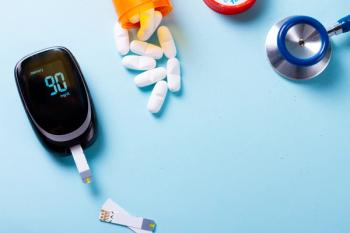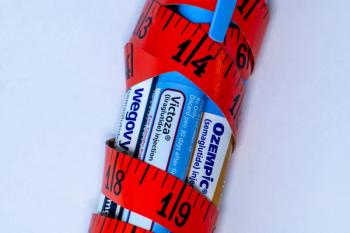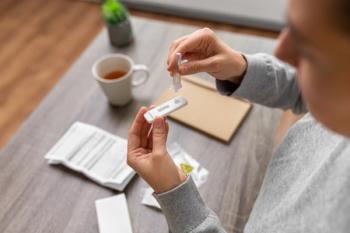
Episode 6: High Risk: Diabetes and COVID-19
In this episode of Over the Counter, 2 experts on diabetes management and care discuss the effect COVID-19 is having on individuals with diabetes and the ways that the health care system is responding.
Drug Topics®: Hello, my name is Gabrielle Ientile and you're listening to episode 6 of Over the Counter the podcast from Drug Topics®.
SARS-CoV-2, the virus that causes COVID-19, has been found to manifest more severely in people with 1 or more underlying medical conditions. While COVID-19 is a fairly new disease, with limited conclusive data on the virus, the CDC has asserted that there is definite evidence that those with type 2 diabetes are at increased risk of severe illness from COVID-19.
In this episode of Over the Counter, 2 experts on diabetes management and care discuss the effect COVID-19 is having on individuals with diabetes, the ways that the health care system is responding, and how pharmacists are positioned to support individuals with type 2 diabetes during the pandemic.
SARS-CoV-2 has reared its head as a worsening factor for individuals with diabetes, as it can cause metabolic complications through direct negative effects on Beta cell function. These effects may be leading to diabetic ketoacidosis in individuals with diabetes, hyperglycemia at hospital admission in individuals with unknown history of diabetes, and potentially new-onset diabetes, according to a recent study published in the Lancet
Most available data showing the effects of COVID-19 on those with diabetes refers to patients with type 2, though research is also beginning to focus on type 1 diabetes as well.
Cox: Well, historically, I have done many aspects of diabetes care. I've both been inpatient, outpatient, I've been in a multidisciplinary setting. I've been in an endocrinology practice. And now I'm in a pediatric endocrinology practice. So I work 1 on 1 with patients. And what I've been doing since COVID, is we are doing virtual. We're doing zoom with our people with diabetes versus 1 on 1, which is not nearly as cool for me, but it is still getting the job done. And we're starting a lot of people on new technologies and diabetes that if I didn't do virtual, we would not be there.
Drug Topics®: That’s Carla Cox, registered dietician and certified diabetes educator. Cox wants to assure those with diabetes that their risk of being infected with COVID-19 is not higher than anyone else.
Cox: First of all, it's important for people with diabetes, particularly those that are well managed, that their risk of getting COVID-19 is no greater than anybody else. I have a lot of people that are kind of hiding, because they're so worried about getting it. But in reality, they're not at a greater risk. So that's something everyone should know.
Drug Topics®: But if a person with diabetes does become infected, Dr. Cox explains who is at highest risk of having serious symptoms or dying from SARS-CoV-2.
Cox: If they do get COVID-19, and they're in the older population group over the age of 60, and they have a comorbid condition, particularly in the relationship to diabetes, if their diabetes is been poorly managed - so that means to me if they've had a lot of variability in their glucose or if it's been chronically elevated for a long time, which some people live with.
If they have those things, then they're much higher risk of morbidity and mortality than they are if they're have diabetes, and they're well managed. Also, people with diabetes that have had it for a long time, particularly those with type 2 diabetes, and obesity, and that are not once again, as well managed as one would hope. Many of them also have heart disease. That's a real common side effect. And so those people that have both high glucose numbers, and heart disease are at much higher risk.
Drug Topics®: So what can those with diabetes do to prevent these serious complications?
Cox: Number 1 is managing their diabetes throughout a lifetime is important for a whole host of reasons. And 1 of those is of course, if you get sick, it's much more difficult to manage their glucose values when they're sick. And if it's already been high, it makes them much more susceptible to a progressing problem. Ways to prevent that: 1, manage diabetes well, and then do the things that other people are doing.
Washing their hands when they're out in public, when they get back home, that's always important for all of us, regardless if it's COVID, or if it's anything else. We get flu every year, so they need to be doing that anyway, they should get a flu shot. That's another thing has been proposed even for COVID even though it doesn't affect COVID. They don't want to 2 things happening at once, right? At least that's my understanding.
I think the other thing is, don't be close to people are sick. If you're ill, if someone is ill, you're supposed to go to a family party, and someone is really ill, a good idea is to just call up and say, “You know, I think I'm going to go next time, but this time, this is probably not where I need to be to prevent them from getting sick to start with.”
The other thing they need to do is be prepared. They should have plenty of glucose strips available, or a second sensor if they're wearing a continuous glucose monitor, so they're always able to check their glucose in case they do get sick and they should have a sick day plan provided by their healthcare provider.
Drug Topics®: Dr. Cox mentioned continuous glucose monitoring, or CGM technology. Prior to the pandemic, people with diabetes didn’t have the option to use CGM in the hospital. However, in response to the pandemic and the challenges it has posed for hospitals, the FDA has decided to authorize its use.
Miller: I am the medical director of diabetes care for Stony Brook Medicine on Long Island. We're the largest academic medical center in Suffolk County. We provide care for over 7000 patients with diabetes a year in the hospital, and 10s of thousands of patients in the community with diabetes and other chronic diseases. I have been a diabetologist now for about 8 years, but I've been a diabetologist in another sense for far longer. I've been living with type 1 diabetes for the last 21 years and have a particular interest in devices that help my patients and helped me live a better life with diabetes.
Drug Topics®: Dr. Miller explains continuous glucose monitoring compared to flash.
Miller: In the CGM space, there are 2 paradigms of CGM that we generally utilize. There's continuous CGM, and then there's what we call flash CGM.
Flash CGM is directed by the patient or the provider, swiping a monitor over the device transmitter to then read the blood sugar result. Continuous CGM delivers a blood sugar result from a transmitter on the patient's body to a receiver or by Bluetooth to a cellular device in a continuous fashion, so you get a minute by minute readout of the blood sugars, instead of having to prompt an individual to swipe the transmitter.
I think ultimately, there are populations of individuals that benefit from the different paradigms of CGM. I've seen patients do remarkably well with the flash CGM, and I've seen patients do remarkably well with continuous CGM in our hospital and in the ICU.
The reason that we chose continuous CGM, I think is apparent, which is that we wanted to limit the number of times that the nursing staff had to go to the bedside, being exposed to COVID-19 and utilizing PPE, for reasons solely to check or swipe a blood sugar, and rather being able to look at that continuous feed outside the room and remotely is really what we were looking for.
Drug Topics®: CGM has been implemented at his hospital in Stony Brook, New York, as he mentioned, to protect healthcare workers and conserve PPE resources.
Miller: We've seen CGM to be transformational i helping us to care for patients with COVID-19 during the pandemic. Early on in the pandemic, as you know, New York was hit hard with the early surge and Stony Brook Medicine was 1 of the institutions that had to rise to the occasion in helping the community deal with the virus.
And part of our plan in helping our staff to care for patients with the virus was to lower to the extent that we can the impact the virus might have on staff and their safety, while maintaining the highest standards of care in providing care for patients.
Back in the spring, the FDA gave guidance to industry about CGM, in so far as they allowed industry to fulfill orders for CGM systems to be used by hospitals amidst the pandemic. We were delighted. We have a diabetes program at Stony Brook with a multidisciplinary team of staff people that are focused day in and day out on caring for people with diabetes. And so we have the architecture, the infrastructure, to implement CGM successfully during In the pandemic.
Drug Topics®: Dr. Miller shared the data from his hospital on the basis of diabetes prevalence and morbidity from the SARS-CoV-2 virus.
Miller: I will tell you what our institution, and we're in the process of publishing this data, we have shown that people with diabetes admitted to the hospital of COVID-19 have a significantly higher mortality rate, significant morbidity as well in terms of risk of going on the ventilator, time to get weaned off of the ventilator, and whatnot. Diabetes is most certainly a comorbidity and a risk factor for COVID-19. I think, as more data is shared, and more institutions and systems collaborate, like we are at Stony Brook, I think we'll learn a lot more that we'll be able to share with the public about their specific risks in both getting the virus and in surviving the virus long term.
Drug Topics®: Let's take a quick break. Up next, Dr. Miller explains how the use of CGM at Stony Brook has been distinct from other institutions. We'll be right back.
Don’t forget to nominate your favorite pharmacy, pharmacist, or pharmacy technician for
Welcome back to episode 6 of Over the Counter. We left of with Dr. Miller from Stony Brook Hospital, explaining how their use of CGM has been distinct from other institutions.
Miller: Our use of CGM at Stony Brook during the pandemic was somewhat novel.
Many institutions use CGM in different populations of patients than we did. We deployed continuous glucose monitors in the sickest of patients. We use CGM as we continue to use CGM in admitted patients with diabetes and COVID-19, who were critically ill in our intensive care units.
The reason for that approach is we felt that those sickest patients were those individuals that required the most intense monitoring of their diabetes in the blood sugar control, as well as the most aggressive approach to insulin management and medications to control diabetes. Having that added insight by using CGM in the ICU, profoundly impacted care for those patients.
We also use CGM in the ICU because every time a nurse has to go into the room of a patient with COVID-19, he or she has to don full PPE and that utilizes a lot of equipment over time, that amidst the height of the pandemic and the surge in New York in the tri state area, we were as focused as anyone on conserving PPE to keep our staff safe. CGM for our patients in the ICU allowed our nurses and our team to safely monitor patients just outside of the room so that they did not have to don full PPE every time they went into the room to check blood sugar for the patient.
And so our preliminary data has shown a reduction in PPE utilization for our staff and upwards of 50%. We were able to reserve and conserve PPE all the while maintaining our high standards of care for patients with diabetes, while having increased access to that glucose tracing on the CGM that we did not have before.
I would say overwhelmingly, it's been transformational for patient care, it's been transformational for our clinical team, and it's been transformational for our nursing staff who are helping us to monitor and care for our patients.
Drug Topics®: A key question here is how do COVID-19 patients with diabetes compare CGM with fingerstick glucose monitoring in the hospital setting?
Miller: Most patients living with diabetes, especially those with type 1 diabetes at a larger set of patients with type 2 who now fortunately have access to technology are very tech savvy.
I've never offered a CGM to a patient and not have the patient come back to me and say, “I love the CGM.” My patients tend to really appreciate the role that CGM can have in their day to day lives and their quality of life living with diabetes.
And a lot of what my patients focus on with CGM is safety. When you're admitted to the hospital with diabetes even before COVID-19, your blood sugar monitoring was limited to the timing that the nurse would come through to do a fingerstick. And while that finger stick is more than adequate to help manage diabetes in the hospital, and to help govern how much insulin or other medications the patient may require to control the blood sugars, those fingersticks only provide part of the data, part of the picture. They don't tell the complete story.
And so patients who are able to use CGM in the hospital have a far greater degree of autonomy and they tell me that they feel safer. They have a safety net beneath them where they can look at the monitor and know what their blood sugars are, know in what direction the blood sugars are going, so that they can be proactive in communicating with the care team about next steps. It is a far more thorough story to tell when someone is wearing CGM in the hospital than just adhering to those timestamps of fingerstick data.
Drug Topics®: With this very recent implementation of CGM in hospitals has it shown to be reliable?
Miller: That was everyone's concern across the board. We all in the diabetes community feel that the FDA and other regulatory agencies are moving towards allowing CGM use in the hospital.
They have not given that widespread approval yet, and I believe the reason for that is they have not had adequate validation data presented to them. But I do know that the companies are working in earnest on producing that data.
The FDA, and the physicians and nurses that care for patients, need to know that the devices they're using are reliable and valid. And when I look at the blood sugar readout on the meter, and I look at the blood sugar readout on the CGM, I want to make sure that they're concordant.
The general rule of thumb that we tend to use when we're comparing a tradition blood sugar monitoring in the hospital, whether it be a capillary fingerstick, or whether it be a blood sugar checked from an arterial line or a venous line, is the sugar by traditional means should be within 20% of the CGM, or vice versa. There should be a 20% rate of concordance.
When we deployed our CGM in the hospital for the first day plus of using the CGM, we did not actually allow the nurses to drive treatment based on the CGM tracing. And our diabetes team and myself rounded on every patient, looked at the monitors, compared the device readouts to the traditional point of care testing that we used as part of usual care every hour in the ICUs, and made sure that the tracings we were seeing were accurate, that they fell within that 20% threshold. Across the board, our sensors were accurate. Across the board, we can look side by side of the continuous glucose monitoring data and the traditional blood sugar data and show the CGM to be accurate.
It became clear probably within 2 weeks of using the devices as to how accurate they were in our population of patients. With that said, we deployed CGM under the guidance of an expert team, of a diabetologists, diabetes educators, nurse practitioners in the like. Having that support in place allowed us to validate the devices so that we were maintaining safety across the board for our patients, and so that nurses knew that they could rely on the devices as they rendered care for patients with diabetes. I think that support is paramount.
Drug Topics®: Other key takeaways from all of this, according to Dr. Cox, is to put this data into context of overall diabetes management strategies.
Cox: The same thing we've been saying for a long time, and that is that managing diabetes, preventing complications, all of those things will help prevent severe comorbid conditions or prevents severe illness, if they're on top of that before they get sick.
I think that's the message we've been talking about for a long time. And if they manage their diabetes, well, there is a much lower risk of ever having some of these conditions that make them at higher risk.
The other thing that people can do, if they're also struggling with weight management, if they're able to keep their weight within a reasonable range, that's going to help them too, because apparently with this particular virus, that those that are carrying a lot of extra weight are not doing very well. So that's another thing we can learn from this.
And hopefully, it's a reboot. People that have had diabetes for a long time, it's a very tedious disease, whether you have type 1 or type 2 diabetes. Checking your glucose all the time, thinking about what you're eating, doing your exercise, all those kinds of things, and sometimes after years of doing that, and maybe relaxing your own standards, this is a reboot to say, “Oh, I really do need to take care of this. This is very important for me, not just about the diabetes, but about if I get sick, and I've managed my diabetes, I'm going to probably do better.”
Drug Topics®: And what can the future look like for diabetes care in the hospital setting?
Miller: I sort of envisioned in my mind, much in the same way that cardiologists use continuous telemetry, where they have screens set up in the hospital for nurses and telemetry staff to follow someone's heart tracing continuously throughout the day to monitor them for safety and fatal arrhythmias and risk of other cardiac abnormalities. I very much envision that to be the way of, hopefully, the near future in the inpatient diabetes world, where I'll be able to look virtually at a continuous tracing of blood sugar throughout the day and night for my patients. I can monitor them remotely, nurses can look from a central station at all of the patients on the unit with diabetes to see what their blood sugar's look like. People in the food service department who deliver food up to the floors and trays for our patients to eat, they'll have an understanding what blood sugars are.
I think it's a far more robust story to tell and I think we're all eager to be able to tell it so long as we can do so safely and with the blessing of the regulatory agencies that are there to keep our patients safe.
Drug Topics®: That's all for this episode of Over the Counter. Make sure to tune in next week for insights from industry experts on the latest news trends and innovations in pharmacy.
And as always, if you enjoyed this podcast, please like write a review and share with your pharmacy friends. Thanks for listening.
Newsletter
Pharmacy practice is always changing. Stay ahead of the curve with the Drug Topics newsletter and get the latest drug information, industry trends, and patient care tips.





















































































































































